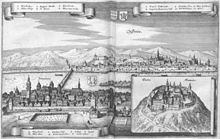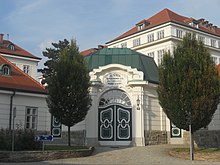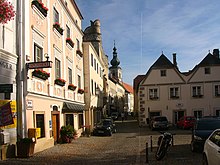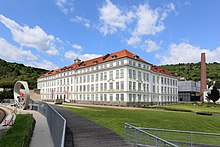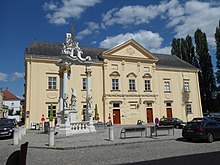Stein on the Danube
|
Stein an der Donau ( district ) locality Cadastral community stone |
||
|---|---|---|
|
|
||
| Basic data | ||
| Pole. District , state | Krems-Stadt (KS), Lower Austria | |
| Judicial district | Krems at the Donau | |
| Pole. local community | Krems at the Donau | |
| Coordinates | 48 ° 24 '6 " N , 15 ° 34' 55" E | |
| Residents of the village | 2116 (January 1, 2020) | |
| Building status | 510 (2001) | |
| Area d. KG | 3.66 km² | |
| Post Code | 3500 | |
| prefix | + 43/2732 | |
| Statistical identification | ||
| Locality code | 03153 | |
| Cadastral parish number | 12132 | |
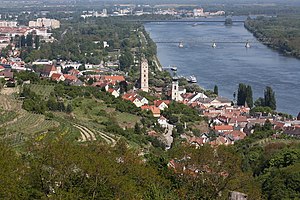 West elevation from stone |
||
| Source: STAT : index of places ; BEV : GEONAM ; NÖGIS | ||
Stein an der Donau is a district of Krems an der Donau . For centuries it was a separate town and was not attached to Krems until 1938. Just like the city center of Krems, the city center of Stein an der Donau is part of the UNESCO World Cultural and Natural Heritage Wachau .
location
Stein is located at the beginning of the Wachau, on a relatively narrow stretch of shore below the gneiss terraces of the Waldviertel , which slope steeply towards the Danube . As a result, the settlement area is narrow and very extensive in an east-west direction. Only at the east end, at the monastery and the settlement area is widening, where nowadays it merges seamlessly into the Krems city center. In the west of Stein the Reisperbach flows into the Danube.
The main axis of the city is the Steiner Landstrasse , which also connects the two preserved gate towers and, as Stein-Emmersdorfer Strasse, represents the former east-west connection in the Danube Valley. After the Mauterner Brücke , this historic street continues on Förthofstrasse. The local district of Förthof (around the residence of the same name) has its own soft image of the settlement. The Steiner Donaulände, which is connected to the Steiner Landstrasse via four almost square squares, runs parallel to it. A steep ascent to the Frauenberg begins north of the country road, which is crowned by the Frauenberg Church, located directly above the parish church.
history
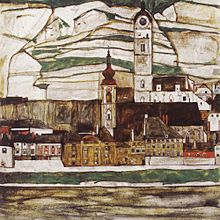

The oldest settlements in the Krems-Stein area were not permanently inhabited, but at least date back to the Neolithic . The riverside settlement below the Frauenberg (on which there was originally a St. Michael's Church, which perhaps goes back to Carolingian times) developed from the 11th century. Stein was mentioned in 1144 and before 1200 as a sovereign customs post. In the late 13th century, the town, which previously stretched from today's Köchelplatz to today's Schürerplatz, was expanded; the city wall was also built at this time, which included several monastery reading yards and was expanded around 1480. In 1263 the Church of St. Nicholas was elevated to the status of a parish church. The oldest written city law has come down to us from 1305, but it probably dates back to the Babenberg era. Even then, Stein was connected to the neighboring town of Krems through a joint municipal law and administration.
In the 15./16. In the 18th century, the city experienced its peak as a trading city, the old town is therefore significantly shaped by the almost completely preserved building fabric from that time.
The Capuchins settled here in 1614 and founded the Und monastery between Krems and Stein , which was rebuilt in 1656 after a fire. In 1645 the city was conquered by the Swedes after a yearlong siege during the Thirty Years' War and then recaptured by the imperial troops, whereby a good part of the housing stock was destroyed. In particular, the city castle, which was located on a hill above the Reisperbach, was damaged and was not repaired until it was demolished in 1799. In 1756 Martin Johann Schmidt became a citizen of Stein, he lived and worked here until his death in 1801.
In the battle of Dürnstein (November 11, 1805) at the gates of Stein, the Austro-Russian troops defeated the French under Mortier , but the 3rd coalition war after the battle of Austerlitz was lost.
In the course of the administrative reforms in the wake of the 1848 revolution , Stein was constituted as a township in 1850.
In the middle of the 19th century, the city grew mainly in the east. A Redemptorist convent was built between 1839 and 1843, but it was closed in 1848 and converted into the Stein prison. In the middle of the 19th century, the tobacco factory was also established, which after expansion at the beginning of the 20th century took up an extensive complex that today houses the Danube University and the Krems art gallery. At the beginning of the 20th century, workers' housing estates were also built for the tobacco factory, which are a striking testimony to early social housing.
In 1938, after the annexation of Austria, Stein was incorporated into Krems together with twelve other municipalities, which should have been generously expanded as the district capital. The effects of National Socialist rule lay in the persecution and expulsion of the Jewish citizens, but above all in the inclusion of the Stein prison in the National Socialist apparatus of terror. On April 6, 1945 there was the Stein massacre , in which 229 political prisoners and five prison guards were shot by units of the Schutzpolizei, the Kremser Volkssturm, the Wehrmacht garrison and the Waffen SS. In the days that followed, a real hunt for more released prisoners began in the urban area of Krems and the surrounding area. On April 7th, 61 recaptured prisoners were victims of a firing squad of the Waffen SS in the Hadersdorf am Kamp cemetery .
In the Second Republic, Stein remained part of the statutory city of Krems and essentially shared its development. In the 1990s in particular, the district received new impulses from the settlement of the Danube University (in the abandoned tobacco factory) and the Krems art gallery . The museums located at the beginning of Steiner Landstrasse are run under the umbrella brand Kunstmeile Krems and combine, among other things, the Krems cartoon museum , built in 2001 , the Artothek , the Frohner Forum , which is housed in the former Minorite monastery, and many other facilities. In 2000, the old towns of Krems and Stein are declared a UNESCO World Heritage Site as part of the Wachau .
See also: History of Lower Austria .
traffic
The Wachau Railway runs through Stein , it has two train stations ( Campus Krems-Kunstmeile Krems and Stein-Mautern ), with the Goldberg Tunnel and the Steiner Tunnel in between.
Stein is located on Donau Strasse , which was expanded into a federal road in 1954 and passed the city on the Danube side. In the 1990s this road was replaced by another bypass on the Danube side. The original Stein-Emmersdorfer Straße through the city center is now largely free of traffic.
Colleges and universities
- Danube University Krems
- Danube Private University
- Karl Landsteiner Private University for Health Sciences
- IMC University of Applied Sciences Krems
Culture and sights
- See also: List of listed objects in Krems-Stein
Both in the Krems and Stein districts, there are closed old town stocks, the one in Stein has remained structurally largely unchanged. However, the small commercial uses as well as the small trading companies have largely disappeared.
In recent years numerous initiatives have been taken to revive Stein and the former monastery Und.
The Kunsthalle Krems (with changing exhibitions, with a focus on contemporary art) and the Krems Caricature Museum (permanent exhibition by the artists Manfred Deix and the architect-caricaturist Gustav Peichl ( Ironimus ) as well as special shows), a literature house and local initiatives are particularly noteworthy.
Notable buildings
- Danube University : Since October 2005 the University of Krems, IMC University of Applied Sciences Krems , Krenek Foundation and Austrian Film Gallery have all been united on the Krems campus . Partly in a former tobacco factory, mostly housed in the new buildings on campus, based on plans by the architect Dietmar Feichtinger .
- Kloster Und : The profane monastery has significant frescoes by Daniel Gran .
- Stein Prison : The older parts of the building were built in 1839–1843 as a Redemptorist convent and are under monument protection.
Krems art mile
There are several museums in Stein that are known under the umbrella brand Kunstmeile Krems .
- Caricature Museum Krems : planned by Gustav Peichl and opened in 2001, is located opposite the art gallery.
- Kunsthalle Krems : is housed in the former tobacco factory building next to the prison on Franz-Zeller-Platz. The adaptation to the exhibition house took place in 1994/95 according to plans by Adolf Krischanitz . Main building of the Krems art mile.
- Art space stone
- Ernst Krenek Forum
The Austrian Film Gallery, which works very closely with the Austrian Film Museum and the Filmarchiv Austria in Laxenburg , is also located within the Kunstmeile .
Old town of stone

- Former Frauenberg Church : Gothic building from the 14th century, after restoration from 1963–1965, dedicated as a memorial to those who fell in the two world wars.
- Göttweigerhofkapelle: Chapel of the former farm yard of the Benedictine monastery Göttweig with chapel and Gothic frescoes, dated around 1300.
- Holzingerhaus
- Großer Passauerhof: First mentioned in 1263, Zehenthof of the Bishop of Passau, building in today's appearance between 1550 and 1600 made up of three individual houses.
- House of the Regions , the former guest house Zum Goldenen Elephanten , Steiner Donaulände, first documented in writing in 1721.
- Kremser Tor: Eastern end of the medieval city fortifications towards the city of Krems. Built around 1470.
- Linzer Tor (or bridge gate ): built in 1477 (plaque with Gothic numerals walled in on the field side), supplemented by a structure with a mansard roof around 1750/70, renewed in 1949 (plaque also on the field side).
- Residence of the baroque painter Martin Johann Schmidt (1718–1801), inhabited by him from 1756. The six-axis facade of the building, which is now a listed building, was designed in the third quarter of the 18th century. It is structured on the main floor by pilasters. A central gable rises above the two central axes. The ground floor is grooved .
- Mauthaus: The bridge toll collector's house (toll collector), built in 1536, changes in 1576, restored in 1943/44 (plaque on facade). Facade with fresco decoration in the Renaissance style. The actual toll house was outside the Linzer Tor in the west of the city.
- Mazettihaus: Schürerplatz; named after its builder; was house Ludwig Ritter von Kochel (born in 1800 in stone), the author of Kochel directory of the works of Mozart .
- Minoritenkirche Stein : consecrated in 1264, today the event room Klangraum Krems and museums (Forum Frohner , Ernst Krenek Forum, Kunstraum Stein) in the adjoining monastery building.
- Catholic parish church Stein an der Donau hl. Nikolaus: Late Gothic, dated end of the 14th / end of the 15th century, contains several works by Schmidt from Krems.
- Salzstadl: Salt storage building from the 16th century. Due to an imperial privilege, Stein was the transshipment point for the Bavarian and Salzburg salt shipped down the Danube for the countries of northern Central Europe such as Bohemia, Moravia, Silesia, etc.
- Steiner Rathaus: used as the town hall of Stein from 1701, facade from 1779 by Johann Michael Ehmann.
- Ruin Stein : Erected before 1336, destroyed in 1645. Possibly the location of a Roman base north of the Danube. Excavation finds from the urn field culture and the early Middle Ages .
Förthof
- Förthof : A four-wing complex, the core of which dates from the 16th century.
- Förthof chapel: now a branch church of St. Matthias, an early Gothic hall church
Personalities

- Martin Johann Schmidt (1718–1801), known as "Kremser Schmidt", the most outstanding painter of the Austrian Rococo , lived in stone
- Karl Ehmann (1777–1829), royal Esterházy court and town architect
- Franz de Paula Schürer (1822–1886), winery owner and from 1878 mayor of Stein, from 1861 member of the Lower Austrian state parliament, 1867–1878 and 1885–1886 member of the Reichsrat (Progress Club)
- Ludwig von Köchel (1800–1877), creator of the catalog raisonné by Wolfgang Amadeus Mozart
- Franz Lorenz (1803–1883), doctor and writer
- Augustin Weigl (1845–1914), pioneer of tourism in the Wachau
- Robert Kratky (* 1973), Austrian radio presenter, lives in Stein
- Rudi Pietsch (1951–2020), Austrian folk musician (Heanzn), professor at the University of Graz
literature
- Dehio Lower Austria north of the Danube , p. 590 ff.
- Josef Kinzl: Chronicle of the cities of Krems, Stein and their immediate vicinity. With the letters of freedom from both cities and the documents of their industrial guilds from the years 985–1869 , Krems 1869.
Web links
- Entry about castle ruins Stein on Lower Austria castles online - Institute for Reality Studies of the Middle Ages and the Early Modern Era, University of Salzburg
Individual evidence
- ↑ see Jagschitz, Gerhard (ed.): Stein, April 6, 1945. The judgment of the Vienna People's Court (August 1946) against those responsible for the massacre in the Stein prison . Federal Ministry of Justice / Documentation Archive of the Austrian Resistance, Vienna 1995



